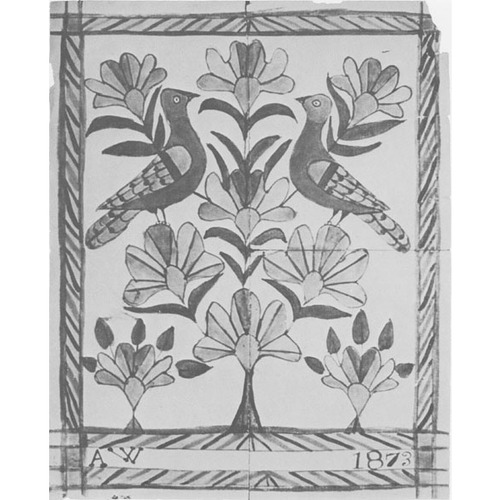![Two Birds in Flowered Tree, by Anna Weber
Source: Anna's art : the fraktur art of Anna Weber, a Waterloo County Mennonite artist, 1814-1888
E. Reginald Good. -- Kitchener : Pochauna Publications, [1976]. -- 48 p. : ill. (some col.) ; 26 cm. -- ISBN 0969063008. -- P. 26
© Public Domain nlc-4385 Original title: Two Birds in Flowered Tree, by Anna Weber
Source: Anna's art : the fraktur art of Anna Weber, a Waterloo County Mennonite artist, 1814-1888
E. Reginald Good. -- Kitchener : Pochauna Publications, [1976]. -- 48 p. : ill. (some col.) ; 26 cm. -- ISBN 0969063008. -- P. 26
© Public Domain nlc-4385](/bioimages/w600.9159.jpg)
Source: Link
WEBER, ANNA (sometimes called Nancy), needle-worker and fraktur artist; b. 3 June 1814 in Earl Township, Lancaster County, Penn., the fifth of ten children of John Weber and Catherine Gehman; d. 12 Oct. 1888 in Woolwich Township, Waterloo County, Ont.
Anna Weber, daughter of a Mennonite minister and farmer, immigrated to Upper Canada from Pennsylvania with a party of 13 in April 1825. Her family settled on a farm one mile south of Conestogo in a predominantly Pennsylvania-German Mennonite community. She lived with her parents, and, after the death of her father on 21 Jan. 1854, with her mother, who died on 2 June 1864. For the remainder of her life Anna was moved from household to household within the Mennonite community. She lived at the fringe, and largely at the expense, of her social group until her death, apparently from an accidental overdose of medicine.
After 1835, the year in which Anna had first made a sampler to demonstrate her skill at needlework, she did much stitchery. She made show towels – finely embroidered linen strips decorated with traditional motifs and designs for the hope chests of neighbourhood girls – stuffed animals, including horses and squirrels as toys for children, and hooked mats of hand-dyed woollen materials which depicted stylized scenes.
About 1855 Anna began the painting of distinctive pen and wash fraktur art, which she continued until her death. This form of art had originated in Germany more than two centuries previously but was highly developed by the Pennsylvania-Germans. It is a purely decorative art, often used to illustrate manuscripts, book-plates, and such family records as birth and baptismal certificates. There is a definite lack of perspective in these pieces and scale is ignored. Recurring motifs – hearts, tulips, paired birds, and the tree of life – appear in balanced, usually symmetrical, form. Anna inherited and developed these traditional designs but her actual subjects were usually taken from nature. Instead of the traditional unicorn, for example, Anna would portray a stylized horse.
Practically all of Anna Weber’s fraktur works are signed and precisely dated, with the lettering forming an integral part of the painted frame around each design. Her paintings, which resemble art nouveau stained glass or tiles, display a good sense of composition and colours which are soft and yet definite. The whole effect is one of assurance, and presumably pleasure, in these sprightly finished products which were often made as gifts for children.
The majority of fraktur artists, including Mr Altsdorf who probably taught Anna in Pennsylvania, were schoolmasters. A female fraktur artist was an anomaly but Anna was the most original and prolific of Ontario’s fraktur artists. Although afflicted with dropsy, arthritis, and the ailments of age, her concentrated efforts produced many fraktur paintings, of which about 60 are extant. Anna Weber was said to have been of “unbrilliant mind,” but because of her individualistic temperament she was allowed to sign her paintings – a “sinful” practice in the self-denying Mennonite community. Like much folk art in Canada, Anna’s is dominated by nature and her fraktur paintings also reflect her strong ethnic heritage.
M. S. Bird, Ontario fraktur: a Pennsylvania-German folk tradition in early Canada (Toronto, 1977). E. R. Good, Anna’s art: the fraktur art of Anna Weber, a Waterloo County Mennonite artist, 1814–1888 (Kitchener, Ont., 1976). J. R. Harper, A people’s art: primitive, naïve, provincial, and folk painting in Canada (Toronto and Buffalo, N.Y., 1974). D. A. Shelley, The fraktur-writings or illuminated manuscripts of the Pennsylvania Germans (Allentown, Pa., 1961). J. J. Stoudt, Early Pennsylvania arts and crafts (New York and London, 1964). M. [S.] Bird, “Ontario fraktur art: a decorative tradition in three Germanic settlements,” OH, 68 (1976): 247–72. Nancy-Lou Patterson, “Anna Weber hat das gemacht: Anna Weber (1814–1888) – a fraktur painter of Waterloo County, Ontario,” Mennonite Life (North Newton, Kans.), 30 (1975), no.4: 15–19.
Cite This Article
E. Reginald Good, “WEBER, ANNA (Nancy),” in Dictionary of Canadian Biography, vol. 11, University of Toronto/Université Laval, 2003–, accessed December 31, 2025, https://www.biographi.ca/en/bio/weber_anna_11E.html.
The citation above shows the format for footnotes and endnotes according to the Chicago manual of style (16th edition). Information to be used in other citation formats:
| Permalink: | https://www.biographi.ca/en/bio/weber_anna_11E.html |
| Author of Article: | E. Reginald Good |
| Title of Article: | WEBER, ANNA (Nancy) |
| Publication Name: | Dictionary of Canadian Biography, vol. 11 |
| Publisher: | University of Toronto/Université Laval |
| Year of publication: | 1982 |
| Year of revision: | 1982 |
| Access Date: | December 31, 2025 |



